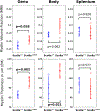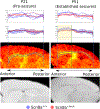Quantitative MRI reveals widespread, network-specific myelination change during generalized epilepsy progression
- PMID: 37574120
- PMCID: PMC11095339
- DOI: 10.1016/j.neuroimage.2023.120312
Quantitative MRI reveals widespread, network-specific myelination change during generalized epilepsy progression
Abstract
Activity-dependent myelination is a fundamental mode of brain plasticity which significantly influences network function. We recently discovered that absence seizures, which occur in multiple forms of generalized epilepsy, can induce activity-dependent myelination, which in turn promotes further progression of epilepsy. Structural alterations of myelin are likely to be widespread, given that absence seizures arise from an extensive thalamocortical network involving frontoparietal regions of the bilateral hemispheres. However, the temporal course and spatial extent of myelin plasticity is unknown, due to limitations of gold-standard histological methods such as electron microscopy (EM). In this study, we leveraged magnetization transfer and diffusion MRI for estimation of g-ratios across major white matter tracts in a mouse model of generalized epilepsy with progressive absence seizures. EM was performed on the same brains after MRI. After seizure progression, we found increased myelination (decreased g-ratios) throughout the anterior portion (genu-to-body) of the corpus callosum but not in the posterior portion (body-splenium) nor in the fornix or the internal capsule. Curves obtained from averaging g-ratio values at every longitudinal point of the corpus callosum were statistically different with p<0.001. Seizure-associated myelin differences found in the corpus callosum body with MRI were statistically significant (p = 0.0027) and were concordant with EM in the same region (p = 0.01). Notably, these differences were not detected by diffusion tensor imaging. This study reveals widespread myelin structural change that is specific to the absence seizure network. Furthermore, our findings demonstrate the potential utility and importance of MRI-based g-ratio estimation to non-invasively detect myelin plasticity.
Keywords: Myelination; Quantitative MRI; Seizure; g-ratio.
Copyright © 2023 The Author(s). Published by Elsevier Inc. All rights reserved.
Conflict of interest statement
Declaration of competing interest None.
Figures











References
-
- Allen P, 2009. Allen Mouse Brain Atlas. Allen Institute for Brain Science.
-
- Altman D, Bland J, 1983. Measurement in medicine: the analysis of method comparison studies. J. R. Stat. Soc. Ser. D (Stat.) 32 (3), 307–317.
-
- Baudo M, Colombo E, Pérez M, Rahn S, Domenech N, Chuang J, Forlizzi V, Buosi P, Baldoncini M, Bendersky M, 2022. Three-dimensional anatomy of the anterior commissure: tractography and anatomical study. World Neurosurg. 159, e365–e374. - PubMed
Publication types
MeSH terms
Grants and funding
LinkOut - more resources
Full Text Sources

